Amazon River Travel Guide – Part 2
Welcome to the taste2travel Amazon River Travel Guide – Part 2!
Forward
A 4,334 kilometre (2,693 mile) meander along the Amazon River from Iquitos, Peru to the Atlantic Ocean in Brazil is an epic voyage and, as such, this travel guide was always going to be monumental in size.
To make the guide more manageable, I have split it into two parts:
- Amazon River Travel Guide – Part 1: contains sections on History, Currency, Visa Requirements, Boat Travel and details on destinations in Peru (Iquitos/ Santa Rosa) and Colombia (Leticia).
- Amazon River Travel Guide – Part 2: contains details on destinations in Brazil –Tabatinga, Manaus, Santarém, Belém, Marajó Island and Macapá.
Enjoy!

Slowly working my way towards the Atlantic Ocean – on a slow boat down the Amazon River.
Destinations – continued from Part 1
Tabatinga (Brazil)
Introduction
The Brazilian border town of Tabatinga forms a single conurbation with neighbouring Leticia – you can simply walk between the two without passing through any immigration formalities.
Tabatinga is a small, gritty, frontier town with an edgy feel to it – there is nothing redeeming about it. The main reason you would come to Tabatinga is for transit purposes. If you are spending any time in the area, neighbouring Leticia is a much more inviting place to spend time.

I spent a total of 7 days cruising along the Amazon with each day ending with an amazing sunset.
Formalities
While in the three-way border zone, you can travel freely between Leticia (Colombia), Tabatinga (Brazil) and Santa Rosa (Peru) without restriction, although you should carry your passport with you at all times. Once you leave the zone, you’ll need to formerly exit whichever country you are departing and formally enter the country you are arriving into.
If you are travelling further into Brazil (or exiting), you will need to visit the Brazilian immigration office, which is located on the main avenue – Avenida da Amizade (Avenue of Friendship). If coming from Leticia, it’s best to take a taxi to the office.
The Brazilian authorities will not stamp you into Brazil until you have been stamped out of your previous country (they do check for your exit stamp).
If you’re traveling on either a Canadian, Australian or United States passport, you will need to obtain a Brazilian visa in advance. There are no visa’s issued upon arrival. Please refer to the ‘Visa Requirement‘ section below for more details.

A passenger ferry near Belém.
Sightseeing
There are no sights to see.
Accommodation
Better accommodation options can be found in Leticia – please refer to that section.
Eating Out
Better restaurant options can be found in Leticia – please refer to that section.
Getting There/ Away
Air
Tabatinga International Airport (IATA: TBT) is located one kilometre from downtown Tabatinga and provides one connection to Manaus, which is operated by Azul Brazilian Airlines.
Boat

Sunset over the Amazon River.
Slow boats to Manaus:
There are two slow boats which depart from Porto Fluvial in Tabatinga each Wednesday and Saturday at 11:00 AM, covering the 1,628 kilometres (1011 miles) journey in 4 days. The cost for hammock space is R$200 while a two-bed cabin costs R$1000. Meals and drinks are available on-board.
Fast boats to Manaus:

Rocketing along the Amazon river on a fast boat from Tabatinga to Manaus.
Fast boats between Tabatinga and Manaus are operated by Cris Transporte Maritimo (also known as Ajato) – who manage a fleet of fast lancha’s. You can access their Facebook page at Gloria de Deus III.

A meal served in my seat on the fast boat from Tabatinga to Manaus.
Currently one fast boat a week travels between Tabatinga and Manaus, departing from the Porto Fluvial on Friday morning, arriving in Manaus 30 hours later.
A one-way ticket costs R$550, which secures you a comfortable aircraft-style seat (i.e. you are sitting upright for the entire journey), access to clean bathrooms and all inclusive meals, which are served in-seat.

Travelling from Tabatinga to Manaus on a fast boat.
Road
You can easily walk across the border between Colombia and Brazil by following the Avenida da Amizade – or you can take one of the many taxis and moto-taxis which cross the border freely.
Getting Around
Boat
Water taxis connect Tabatinga with the Peruvian settlement of Santa Rosa from where you can board boats to Iquitos, Peru.
Road
There are plenty of regular taxis and motorbike taxis on the streets of Tabatinga.
Manaus

A long way from the sea – 1,400 km upriver, an ocean-going freighter approaches Manaus port.
Introduction
With 2.1 million inhabitants, Manaus is the largest city on the Amazon (the 2nd largest is Belém with 1.5 million) and it’s busiest port. The city is located on the banks of the Rio Negro (the largest left tributary of the Amazon River and, the largest black-water river in the world) a few miles before it meets the Rio Solimões to form the Amazon River properly.
The two rivers flow side by side for many miles, different in colour, mixing in eddies: the “Meeting of the Waters.”
Despite being situated 1,400 km (900 miles) upriver from the Atlantic ocean, the Amazon is navigable for ocean-going vessels and the main economic engine of Manaus is the Duty Free port and the Manaus Free Economic Zone.

The Theatro Amazonas, Manaus.
During colonial times, great wealth was generated from rubber plantations during the period known as the Amazon Rubber Boom (1879 to 1912). The proceeds from this boom were used to build magnificent buildings, including a copy of the Grand Opera de Paris – the Teatro Amazonas. Other monuments from this period are the Mercado Municipal, a copy of the famous market halls Les Halles in Paris, and the arts centre Palacio Rio Negro.
Apart from a wealth of history and sights, Manaus serves as a regional travel hub offering onward travel possibilities to Boa Vista, Guyana and Venezuela.
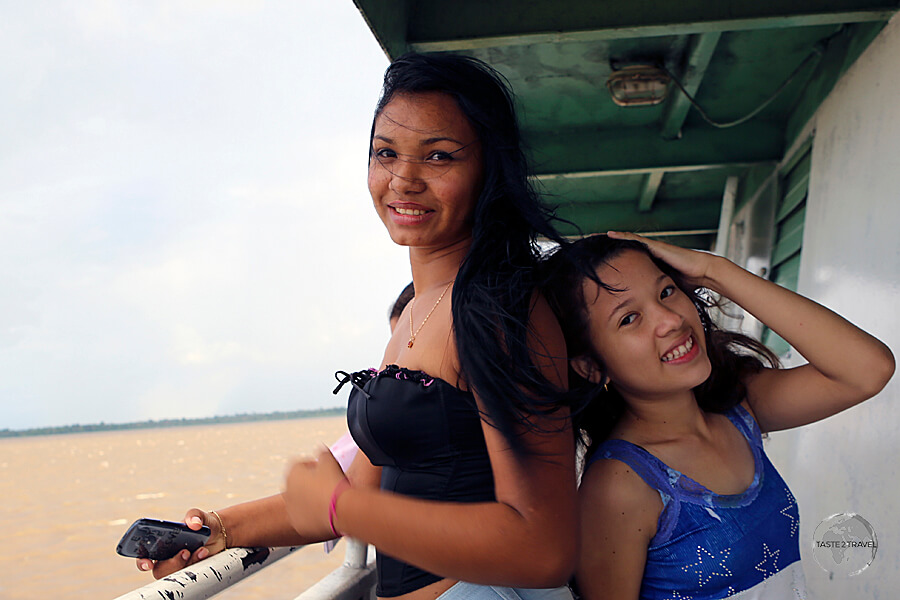
Two girls on the slow boat from Santarém to Belém.
If you’re spending time meandering along the river, Manaus is the best place to take timeout, offering a good choice of accommodation, fine restaurants, bars and cafes and the biggest shopping mall on the Amazon – Amazonas Shopping.
Sightseeing
Theatro Amazonas

The most monumental building in the Amazon region, the opulent Manaus Opera House.
Dominating downtown Manaus, the spectacular Theatro Amazonas is certainly one of the most impressive sights in the entire Amazon region.
Constructed during the years of the rubber boom, when the city was awash with money, no expense was spared on its construction with the roof tiles being imported from Alsace, the steel walls from Glasgow and Carrara marble from Italy.

The ornate interior of the Theatro Amazonas, Manaus.
The dome is covered with 36,000 decorated ceramic tiles painted in the colours of the national flag of Brazil. Concerts are held often and tickets are very affordable at about US$10 each. I saw an amazing concert which showcased the culture of the Amazon, definitely a highlight of my stay!
Mercado Municipal
This ‘touristy’ riverside market is very clean and organised. It’s a good place to buy souvenirs or to have a refreshing fruit juice (made from amazing Amazonian fruits).
Meeting of the Waters

The ‘Meeting of the Waters’, down-river from Manaus.
The ‘Meeting of the Waters’ is one of the most popular sights in Manaus, but actually isn’t in Manaus. In order to see this interesting phenomenon, you’ll need to book yourself onto a boat sightseeing trip or take a slow boat down the Amazon.
This attraction lies at the point where the dark Rio Negro mixes with the sandy-coloured upper Amazon River, or Solimões, as it is known in Brazil.
Despite their coming-together, and due to their different properties, they do not immediately mix, but flow alongside each other. This Meeting of the Waters stretches for 6 km (3.7 miles) before the two different waters eventually blend together.

Our boat from Manaus to Santarém passing through the ‘Meeting of the Waters’.
This phenomenon is due to the differences in temperature, speed, and amount of dissolved sediments in the waters of the two rivers. The Rio Negro flows at near 2 km/h at a temperature of 28 °C, while the Rio Solimões flows between 4 and 6 km/h at a temperature of 22 °C.
The light-coloured water is rich with sediment from the river bed since the Andes Mountains, whereas the black water, running from the Colombian hills and interior jungles, is nearly sediment-free and coloured by decayed leaf and plant matter.
Accommodation
The best place to stay is in the historic old town where you have a good selection of guest houses, restaurants, bars and cafes and everything is within walking distance.
I stayed at the wonderful Boutique Hotel Casa Teatro which is across the road from the Opera house and in close proximity to all the sights in the old town. The neighbourhood is very pedestrian friendly with loads of dining and entertainment options.
If you prefer something more modern, there are many international chain hotels in the new town. There are plenty of options on booking.com
Eating Out
There is no shortage of good restaurants in Manaus, including a quirky revolving restaurant which is located on the top of the Taj Mahal Hotel. The décor is very 1970’s and the restaurant is tired and worn. It all feels like you’re on the set of a vintage James Bond movie set – waiting for the bad guys to arrive. The food, service and views are worthwhile and besides – where else can you eat in a revolving restaurant in the jungle?
Shopping
Manaus offers the same sort of shopping opportunities you would expect to find in any large metropolis. Something that is unexpected in the middle of the jungle is the glitzy, modern shopping mall – Amazonas Shopping – a short taxi ride from downtown. Whatever you need, you’ll find it here, along with a good selection of restaurants.
Getting There/ Away

A budding photographer on the 36-hour slow boat from Manaus to Santarém.
Air
If you don’t fancy spending days traveling on a slow boat along the Amazon river (or if you’re not arriving on a bus from Boa Vista) then flying is your only other option for reaching this remote jungle metropolis. Flights arrive at Manaus International Airport – Eduardo Gomes, which is located 13 kilometres (8 miles) west of downtown.
The following airlines provide regular services:
- American Airlines – flies to/ from Miami
- Azul Brazilian Airlines – flies to/ from Belém, Belo Horizonte-Confins, Boa Vista, Campinas, Cuiabá, Fortaleza, Parintins, Porto Velho, Santarém, Tabatinga, Tefé
- Avior Airlines – flies to/ from Barcelona (Venezuela)
- Copa Airlines – flies to/ from Panama City–Tocumen
- Gol Airlines – flies to/ from Belém, Belo Horizonte, Boa Vista, Buenos Aires-Ezeiza, Brasília, Campo Grande, Cruzeiro do Sul, Cuiabá, Curitiba, Fortaleza, Foz do Iguaçu, Porto Alegre, Porto Velho, Recife, Rio Branco, Rio de Janeiro-Galeão, Salvador da Bahia, Santarém, São Luís, São Paulo-Guarulhos
- LATAM Brasil – flies to/ from Belém, Boa Vista, Brasília, Fortaleza, Miami, Salvador da Bahia, São Paulo-Guarulhos
- MAP Linhas Aéreas – flies to/ from Altamira, Belém, Carauari, Eirunepé, Lábrea, Parintins, Santarém, Tefé
- Rima – flies to/ from Lábrea, Porto Velho
- TAP Air Portugal – flies to/ from Lisbon
- Total Linhas Aéreas – flies to/ from Carauari, Coari, Porto Urucu
A Lost Connection
The national airline of Curaçao, Insel Air, use to provide a very convenient connection from Manaus to Aruba. It was a great way of getting from the jungle onto a white-sand, Caribbean beach in just a few hours.
The flights were never well patronised and not surprisingly the service was terminated. I once took this flight from Manaus to Aruba, which I shared with just one other passenger. The Captain personally came to thank us for flying.

I shared this Insel Air flight from Manaus to Aruba with just one other passenger.
Road
Despite the fanciful lines often drawn onto road maps of Brazil, there are no roads connecting Manaus with the rest of Brazil – except for route BR174 which runs north to the Venezuelan border via Boa Vista (capital of Roraima state). This asphalt highway is in excellent condition, and the buses which ply the route are comfortable and fast.
To Boa Vista:
Frequent night buses run between Manaus and Boa Vista with the 746 kilometre journey taking approximately 12-13 hours. Three different companies offer multiple daily trips with fares ranging from R$157 – R$210. Eucatur offer the only daytime service which departs Manaus at 10:00, arriving in Boa Vista at 21:55. You can book tickets online here.
To Venezuela:
The Venezuelan border is 960 kilometres north of Manaus at the end of BR174. Any journey to the border will require a change of transport in Boa Vista (please refer to the ‘Boa Vista – Getting There‘ section for more details).
To Guyana:
There are no direct transport options from Manaus to Guyana. Like Venezuela, you will first need to travel to Boa Vista then take a bus or shared taxi to the border town of Bonfim then cross the Takutu River Bridge, entering Guyana at the town of Lethem (please refer to the ‘Boa Vista – Getting There‘ section for more details).
Boat
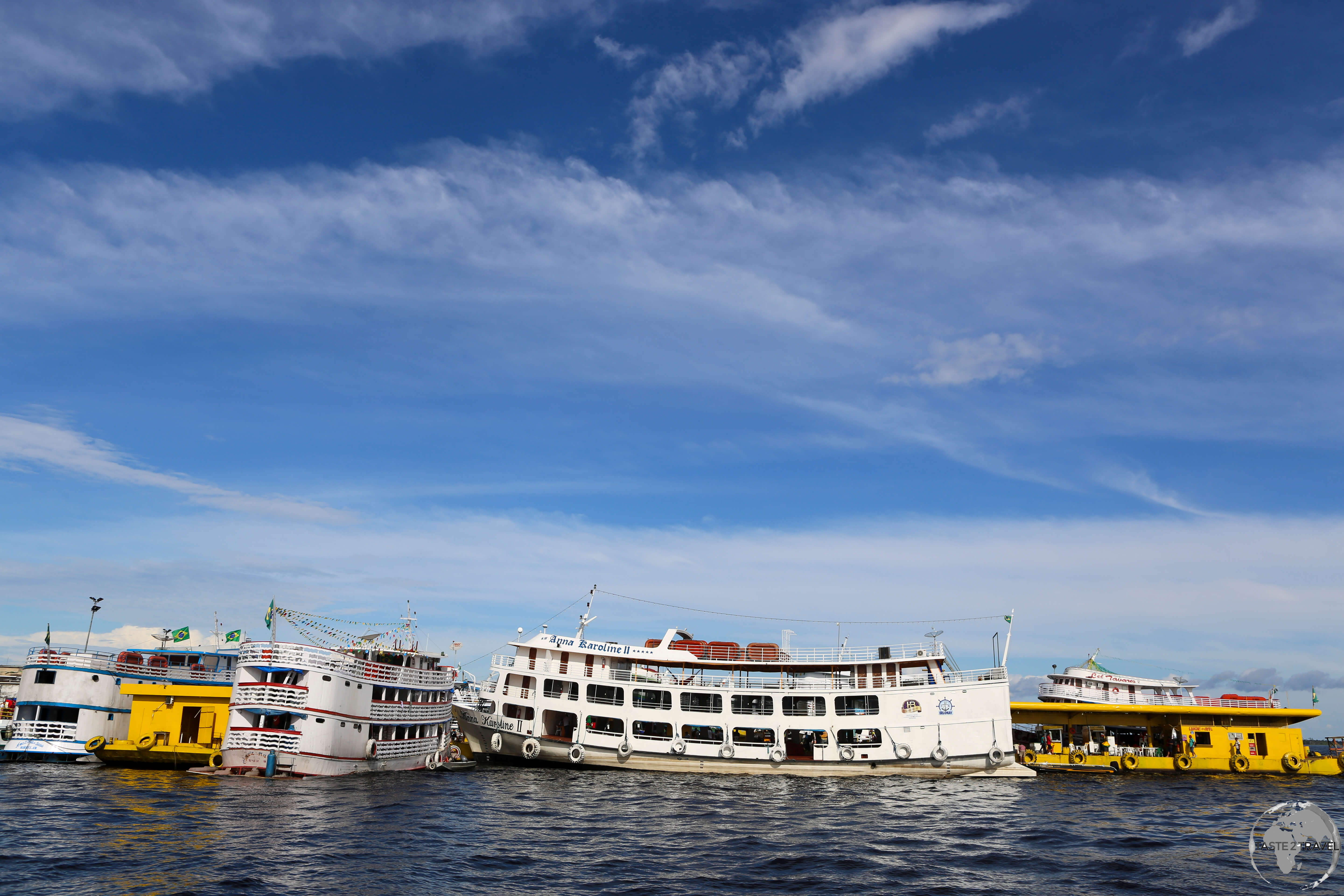
Amazon river ‘slow’ boats docked in Manaus.
Manaus is the busiest port on the Amazon with regular boats departing to all points along the river. Tickets should be purchased in advance from the ticket offices at the dock.
Slow Boats:
Slow boats depart from the chaotic and crowded docks in downtown Manaus. Departures include:
- Manaus to Tabatinga: The up-river journey can take anywhere from 5-7 days. The cost for hammock space is R$330 while a cabin costs R$414 per person (two sharing). Meals and drinks are included.
- Manaus to Santarém: The down-river journey takes about 30 hours. The cost for hammock space is R$80 while a cabin costs R$700 per person. Meals and drinks are not included.
- Manaus to Belém: The down-river journey takes 80 hours with hammock space costing R$220. Meals and drinks are not included.

The captain of my slow boat from Manaus to Santarém.
Fast Boats:
Currently four fast boats a week operate between Manaus and the border town of Tabatinga, completing the 1,628 kilometres (1011 miles) journey in 36 hours. Each boat offers comfortable aircraft-style seats, clean bathrooms and all inclusive meals which are served at your seat.
All boats depart from the ‘Terminal Ajato‘ wharf in Manaus as per the following timetable (current at March 2018):
- The MV Expresso Madame Cris: Departs Thursday at 06:00 am (R$550 per seat)
- The MV Expresso Gloria de Deus III: Departs Friday at 06:00 am (R$600)
- The MV Expresso Cidade de Manaquiri: Departs Sunday at 06:00 am (R$600)
- The MV Expresso Crystal I: Departs Tuesday at 06:00 am (R$600)
The company previously operated a fast boat from Manaus to Santarém but unfortunately suspended their service, leaving passengers at the mercy of the slow (30 hours) boats.
Seating on the boats is limited so it’s best to book tickets in advance on their website (only available in Portuguese) or from their ticket office at the wharf in Manaus. If booking from the wharf you’ll need to show your passport.
Santarém
Introduction
Located on the southern bank of the Tapajós River, at the point where it meets the Amazon River, Santarém lies approximately at the midway point between Manaus and Belém. This city of 300,000 has a good selection of accommodation, restaurants and a few sights, making it an ideal place for a few days’ stopover on a trip along the Amazon River.
Nearby, the pleasant, relaxed riverside town of Alter do Chão offers stunning beaches, amazing restaurants and lots of charming Pousada’s, making it an ideal destination for some well-earned R&R.
Sightseeing
Within town, there are enough sights to keep you occupied for a day, but the main draw is the riverside town of Alter do Chão, which is 40 km west of Santarém.
Santarém

The historic Catedral Metropolitana de Santarém dominates the main square of Santarém.
Overlooking bustling Praca de Matriz, the elegant, powder-blue, Catedral Metropolitana de Santarém Santarém Metropolitan was consecrated in 1761, on the site of the first permanent building in the city.
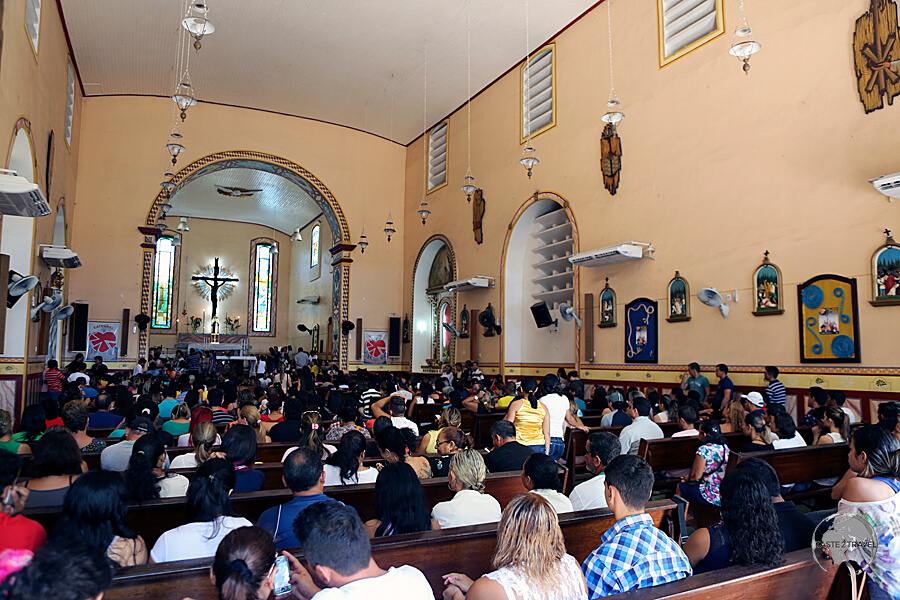
A congregation celebrating mass at the Catedral Metropolitana de Santarém.
The church occupies a commanding position in the old town, close to the river, and while it has an opulent exterior, its interior is very simple and unpretentious.
Mercado Modelo (Amazon Fish Market)

Different species of Amazon fish can be seen at the Mercado Modelo in downtown Santerem.
Across the street from the Teatro Municipal Victória, the Mercado Modelo is the main market in town, where you can get up close with the amazingly large fish that call the Amazon river home.

The Mercado Modelo in Santarém is a great place to view the giant species of fish which inhabit the depths of the Amazon river.
If you’re in the mood to cook up a Piranha, the Mercado Modelo is the place to shop.
Museu Dica Frazão

Dica Frazão providing me with a tour of her unique collection in 2014. Sadly, she passed away in 2017.
Located downtown, the Museu Dica Frazão is a small museum, which is attached to the Frazão family home. This museum displays the amazing creations of Dica Frazão who was born in 1920. She makes women’s clothing and fabrics from natural fibres such as grasses and wood pulp. The work is extremely detailed and most very beautiful.
Items on display include a tablecloth made for Pope John Paul II, ornate handbags, elegant robes and much more. The works are intricate and (as told by Dica herself), very time consuming to produce with some items requiring months of work.
On a sad note, Dica Frazão died at the age of 96 in 2017, but the museum continues with a display room of her creations.
Alter do Chão

Flood waters from the wet season inundate the beaches and promenade at Alter do Chão.
Located on the banks of the Tapajós River, a short bus ride southwest of Santarém is the beautiful, historic village of Alter do Chão, which is also known as the “Caribbean in Brazil“.
Famous for it’s many white-sand river beaches (which contrast spectacularly against the dark water of the Tapajós River), Alter do Chão is where the locals flock to for weekend recreation.
The size of the beaches vary depending on the season – I was there during the wet season so many of the beaches had been totally inundated by flood waters.
A short distance offshore, in the middle of the river, is the beautifully named, and simply wonderful Ilha do Amor (Island of Love). You can either swim to the island or hire a kayak for R$5.
The beaches are also popular with stingrays who like to rest on the sandy bottom. They’ll only sting when stepped on, so the local advice is to shuffle your feet when you walk in the water.
Accommodation
There are plenty of accommodation options in downtown Santarém, all a short walk from the riverfront. I stayed at the Pôr do Sol Hotel, which is located outside of the centre – on the road to the airport – and offers modern, spacious, comfortable rooms at a reasonable price. Booking.com currently lists 15 different properties in the city.
With its sandy beaches and relaxed ambiance, Alter do Chão is an ideal place to relax. Booking.com currently list 28 different properties, many of them reasonably priced Pousada’s.
Eating Out

Piranha can be found on many restaurant menus in Santarém.
Lining the Amazon river waterfront in Santarém are a good selection of restaurants. One of my favourites is Restaurante Nossa Casa, where you can sample fresh Amazonian fish such as Tambaqui, Piranha and Pirarucu (also known as Arapaima) – one of the largest freshwater fish in the world.
Getting There/ Away
Air
Santarém is served by the Santarém–Maestro Wilson Fonseca Airport (IATA: STM), which is named after the famous local composer – Wilson Fonseca.
The following airlines fly to/ from Santarém:
- Azul Brazilian Airlines – flies to/from Altamira, Belém, Carajás, Manaus, Parintins, Porto de Trombetas
- Gol Airlines – flies to/from Brasília, Fortaleza, Manaus, Recife, Rio de Janeiro-Galeão, Salvador da Bahia
- LATAM Brasil – flies to/from Belém, Brasília
- MAP Linhas Aéreas – flies to/from Altamira, Belém, Manaus, Parintins
- Piquiatuba – flies to/from Altamira, Belém, Itaituba, Novo Progresso
Boat
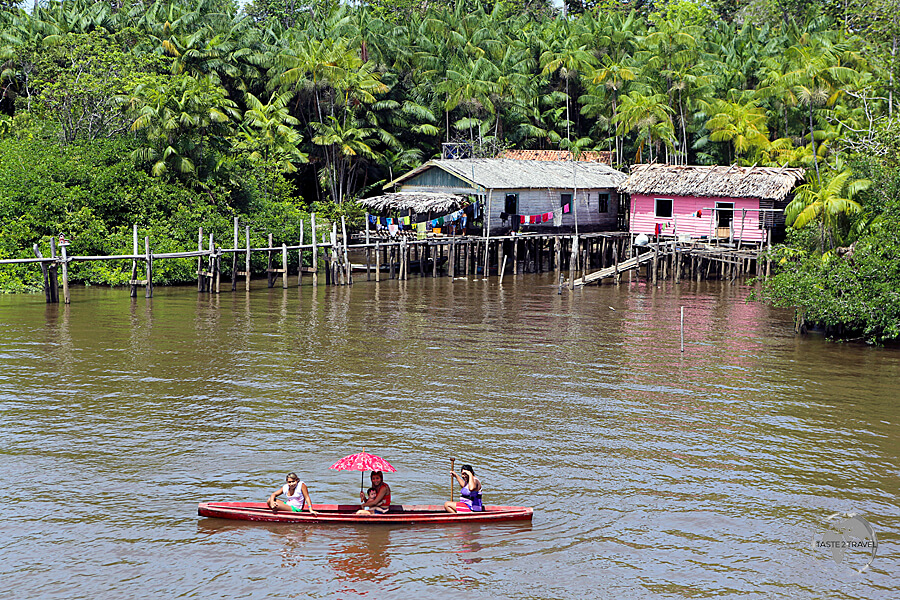
A typical Amazon river settlement between Santarém and Belém.
Boats to Macapá (hammock R$140 including meals, 36 hours, 6:00 PM daily) arrive and depart from Praça Tiradentes, which is located one kilometre west of downtown.
Boats to Manaus and Belém arrive and depart from the Docas do Pará, which is 2.5 kilometres west of downtown. Slow boats travelling upriver to Manaus depart from Santarém daily (except Sunday).
Boats to Manaus
The only option to Manaus is a slow boat with one boat leaving each day (except Sunday) at 12:00 pm. The journey upriver takes 48 hours (versus 36 hours for the downriver trip) with hammock class costing R$130 (USD$32) and a cabin costing R$500 (USD$92).
While agents around town will sell you a ticket at an inflated price, its best to purchase your tickets directly at the Docas do Pará.
Boats to Belém

My cabin on the ‘MV Amazonia’, a slow boat which carried me from Santarém to Belém in 48 hours.
The only option to Belém is a slow boat with boats departing from Docas do Pará at 11:00 am most days. Tickets for the 48 hour journey can be purchased at the port and cost R$180 for hammock-class or R$800 for a private cabin.

The crew of the MV Amazonia loading freight into the hold at Santarém.
I travelled in a cabin on the MV Amazonia which was a pleasant but long (48 hours) journey. We departed Santarém many hours late, while we waited for the crew to load freight into the hold by hand.

Loading sacks of coconuts at Monte Alegre.
In the early hours of the morning the next day, we arrived at the small town of Monte Alegre where the boat docked for an hour or so while huge sacks of coconut were loaded into the hold of the boat.
And so it continued for the rest of the journey, stopping at every settlement to pick up freight.
Patience is a virtue on the Amazon River!

Storm clouds over the Amazon river near Belém.
Getting Around
Public Bus
Municipal buses run regularly to all points in Santarém and to Alter do Chão and the airport.
Taxi
Taxis are plentiful in Santarém and can be hailed on the street. If you wish to reserve a taxi to/from the airport, you can contact the Airport Taxi service company on +55 93 35 22 39 36.
Belém

Located one degree south of the Equator, Belém is one of the wettest places on the planet with almost daily storms.
Introduction
With a population of 1.5 million, Belém is the largest city (and capital) of Pará state and the 2nd largest city on the Amazon River, after Manaus. Founded in 1616 on the banks of the Pará River by Portugal, Belém was the first European colony on the Amazon but did not become part of Brazil until 1775.

Most afternoons, the city of Belém is enveloped by fierce tropical storms.
The city blossomed during the rubber boom of the late 19th century and early 20th century when it accounted for nearly 40 per cent of the country’s rubber exports. The city today is an economic hub with a charming old town at it’s core, which is surrounded by a forest of high rise buildings which comprise the modern new town.

Monuments such as the ornate Theatro da Paz were built in Belém using riches from the rubber boom.
Belém, which translates as Bethlehem, is also known as the City of Mango Trees, due to the vast number of Mango trees which line the city streets. If you visit during Mango season, you’ll find the footpaths littered with fallen fruit.
The city is a centre of culture and learning in Northern Brazil and home to the Museu Paraense Emílio Goeldi, a Natural History and Ethnography museum focused on the fauna, flora and cultures of the Amazon Basin – a ‘must see’ for anyone with an interest in anything ‘Amazon‘.
Sightseeing
Ver-o-Peso Market

Souvenir stalls at the ‘Ver-o-Peso’ market in Belém.
Created in 1688 by the Portuguese who decided to levy a tax on everything entering and leaving Amazonia, the Ver-o-Peso market is the main market for Belém and one of its main tourist attractions. The markets name is derived from the fact that the tax collector’s main post was located in a house which was called the “Casa do Haver-o-peso” (“Have-the-Weight House”). It was in this house that goods were weighed then taxed.

Peppers for sale at the ‘Ver-o-Peso’ market in Belém.
Today the market sprawls over 9 acres of prime riverfront land and is divided into different sections selling meat, fish, fruits, arts, crafts and traditional medicines (which includes an Amazonian version of Viagra).

Preparing a fiery pepper sauce at the ‘Ver-o-Peso’ market in Belém.
The Brazil Nut

Brazil nuts on sale at the ‘Ver-o-Peso’ market in Belem.
One of the most popular products offered at the ‘Ver-o-Peso’ market is the ubiquitous Brazil nut, where a kilo of freshly shelled nuts will cost you R$32 (US$10).

Brazil nuts on sale at the ‘Ver-o-Peso’ market for $R32 (USD$10) per kilo.
In German, the Brazil nut is known as the Para nut, being named after the state of Para of which Belém is the capital. In Portuguese, the nut is known as Castanha do Brasil.

Raw Brazil nuts ready for processing at the Ver-o-Peso market in Belem.
Unlike other nuts, the shell of the Brazil nut does not crack open so the nut can be easily removed. Instead, sellers need to use a knife or guillotine to cut the shell away (piece by piece) from each nut, which is very time consuming and labour intensive.

Unlike most nuts, the hard shell of the Brazil nut cannot be cracked open but must be cut from the nut – piece by piece.

Some nut sellers prefer to remove the shell using a knife rather than a guillotine.
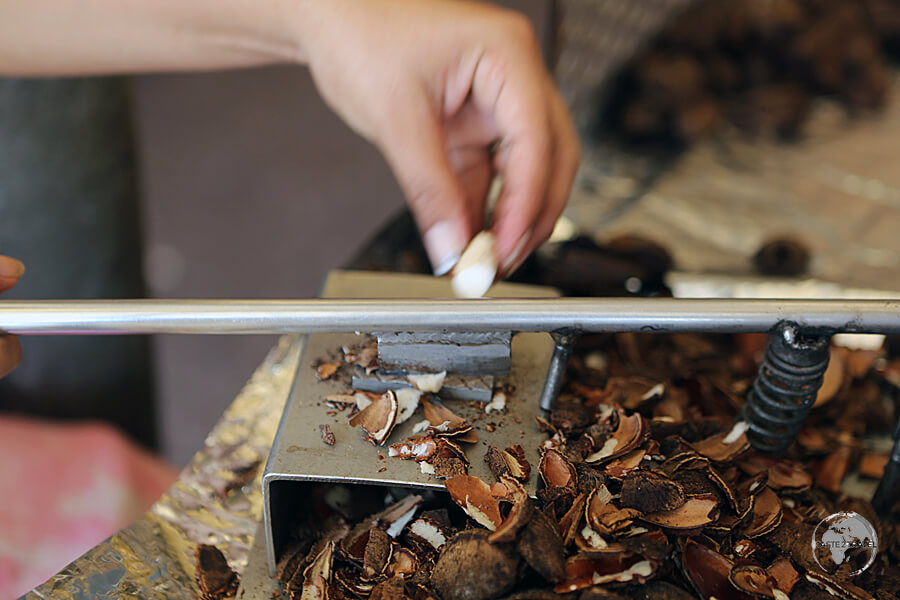
Some traders use small guillotines to remove the shell, which is a little faster than a knife.

Seeing the effort involved in removing the shell of the Brazil nut gives you a greater appreciation of each nut.
After spending time watching the difficult shelling process, I now have a new-found appreciation for these special treats.
Estação das Docas

A former dock on the Amazon river, Estação das Docas has been converted into a modern entertainment area with restaurants, cafes and bars.
Estação das Docas – located on the waterfront, next to Ver-o-Peso market, this former dock and warehouse complex has been transformed into an eating and entertainment space. The main draw is the excellent Cervejaria Amazon – a craft beer brewery (for more on this, please refer to the Eating Out section below).
Forte do Presépio

The Portuguese-built, Forte do Presépio, overlooks the Amazon river in historic Belém.
Located on the riverfront, a short walk from Ver-o-Peso market, Forte do Presépio was built by the Portuguese in the 17th century when the city was founded. Today you can visit a small museum and view the cannons lined up along the river.
In the area surrounding the fort are other historical buildings such as Santo Alexandre Church, which has been converted into a Museum of Sacred Art.
Also nearby is the refined and elegant Casa das Onze Janelas (House of Eleven Windows), which was originally built as a residence for a wealthy sugar plantation owner and today houses the Belém Museum of Contemporary Art.
Belém Cathedral
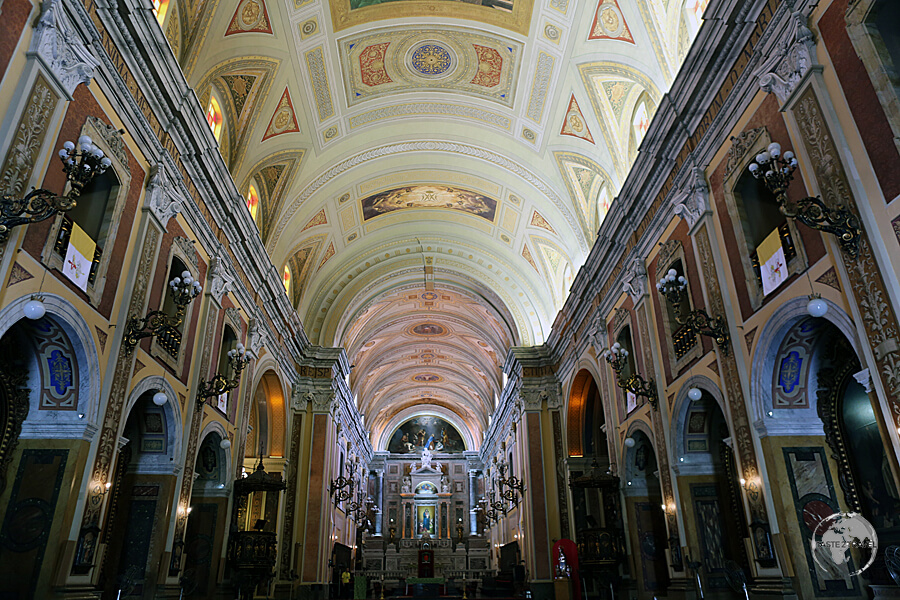
The imposing interior of Belém Cathedral.
Across the road from the fort is the imposing Belém Cathedral (also known as Our Lady of Grace Cathedral) which has neoclassical and baroque influences. Constructed in 1748, the church is the oldest in the city.
Theatro da Paz

The imposing exterior of Theatro da Paz in Belém.
Like the Opera House in Manaus, the Theatro da Paz (Peace Theatre) in Belém was built during the golden age of the rubber boom in the neoclassical style. Overlooking Praça da República (Republic Square), the theatre is open daily for tours which are interesting and informative. Reasonably priced concerts are conducted most evening.
Paraense Emilio Goeldi Museum
Located away from the centre of town, the Paraense Emilio Goeldi Museum is a research institute and museum dedicated to studying and cataloguing the fauna, flora and cultures of the Amazon basin. Originally named the Pará Museum of Natural History and Ethnography, and was later named in honour of Swiss naturalist Émil August Goeldi who reorganized the institution and was its director from 1894 to 1905. The museum is set among lush, tropical gardens and usually features exhibits focused on the indigenous tribes of the Amazon. This is a must-see for anyone interested in the Amazon region.
Mosqueiro Island
Located 67 kilometres north of downtown Belém (near to the Atlantic ocean), the river island of Mosqueiro offers some of the best sandy beaches in the region – 17 kilometres of them. Regular taxis and buses connect Belém and the island, which is especially busy on weekends.
Accommodation

My deluxe, reasonably priced, room at the Golden Tulip Hotel in Belém.
From historical, old town guest houses to modern, high rise hotels, Belém offers a good selection of accommodation for all budgets. One of my favourite hotels is the Radisson, which offers spacious, modern rooms, often at discounted prices. The hotel is located on Avenida Bras de Aguiar, close to many fine restaurants, bars and cafés.
Also nearby is the Golden Tulip Hotel which offers a rooftop pool and deluxe rooms. Booking.com currently list 62 properties in the city.
Eating Out

The Cervejaria Amazon in Belém is the only craft brewery on the Amazon River.
Located on the banks of the Pará River, the Estação das Docas is a former dock/ warehouse complex which has been converted into a dining, shopping and entertainment space.
The most important tenant (and by far the largest) is the Cervejaria Amazon, the only craft brewery on the Amazon River. Beers are brewed using local Amazonian fruits such as Taperebá, Bacuri, Açaí and Cupuaçu.

Craft beer range from Cervejaria Amazon Beer in Belém.
Whatever you’re in the mood for, you’ll find it in the streets around Avenida Bras de Aguiar. This is also a nice neighbourhood in which to base yourself with a good selection of accommodation options (see the ‘Accommodation‘ section above).
Getting There
Air
Belém is served by the Val de Cans International Airport (IATA: BEL)
The following airlines fly to/ from Belém:
- Avianca Brazil – flies to/ from Brasília, São Paulo-Guarulhos
- Azul Brazilian Airlines – flies to/ from Altamira, Belo Horizonte-Confins, Campinas, Carajás, Cayenne, Fort Lauderdale, Cuiabá, Fortaleza, Imperatriz, Macapá, Manaus, Marabá, Palmas, Porto de Trombetas, Recife, Rio de Janeiro-Santos Dumont, Salvador da Bahia, Santarém, São Luís, São Paulo-Guarulhos, Tucuruí
- Gol Airlines – flies to/ from Brasília, Cruzeiro do Sul, Fortaleza, Macapá, Manaus, Marabá, Paramaribo-Zanderij, Porto Velho, Recife, Rio Branco, Rio de Janeiro-Galeão, Salvador da Bahia, Santarém, São Luís, São Paulo-Congonhas, São Paulo-Guarulhos
- LATAM Brasil – flies to/ from Brasília, Curitiba, Fortaleza, Macapá, Manaus, Marabá, Miami, Rio de Janeiro-Galeão, Santarém, São Paulo-Guarulhos
- MAP Linhas Aéreas – flies to/ from Altamira, Manaus, Parintins, Santarém
- Piquiatuba – flies to/ from Altamira, Itaituba, Novo Progresso, Santarém
- Surinam Airways – flies to/ from Cayenne, Paramaribo-Zanderij
- TAP Air Portugal – flies to/ from Lisbon
Boat

A moonlit Amazon River as seen from my boat as we slowly approached Belém.
Belém is a major transport hub for Amazon River traffic with regular boats departing from its docks heading upriver to all ports including Santarém & Manaus. Heading in the opposite direction – regular boats make the 24-hour crossing of the mouth of the Amazon River to the northern city of Macapá, while daily ferries connect the city with nearby Marajó Island.
Santarém

The glow of bustling Belém lights up the sky as I approach on my slow boat from Santerem – the end of a 48 hour journey.
Slow boats for Santarém (72 hours) depart Belém from Terminal Hidroviário 2 days a week – Wednesday and Friday. Tickets can be purchased directly from the company at the terminal and cost R$130 for hammock class or ?? for cabin class. Food is available for purchase with breakfast typically costing R$5 and a lunch and dinner buffet costing R$
Macapá

On-board the M/V Sao Francisco de Paula leaving Belém for Macapá, a journey of 24 hours.
Slow boats travel twice a week from Belém to Macapá, departing Belém at 10:00 am every Wednesday and Saturday. The 482 kilometre (300 mile) journey across the mouth of the Amazon river (the largest river mouth in the world) takes 24 hours with boats arriving in the Macapá port suburb of Santana.

The captain of the M/V Sao Francisco de Paula steering a course to Macapá.
I travelled on the M/V Sao Francisco de Paula, paying R$225 for a berth in a private cabin – hammock space is available for R$120. Food and drinks are available on board.

The Brazilians love to party so many of the Amazon river boats, including the M/V Sao Francisco de Paula, include live entertainment.
Açaí Berries

Açaí merchants loading their haul onto the Sao Francisco de Paula ready for transportation from the remote jungle to Macapá.
During our trip from Belém to Macapá, we stopped mid-river, in the middle of nowhere, and were quickly surrounded by small boats which were filled to the brim with baskets of freshly picked Açaí berries, an Amazonian super-fruit which has become hugely popular around the world.

The Sao Francisco de Paula provides an important link to market for these Açaí merchants who live in the middle of the jungle.
The crews on these boats then proceeded to load our boat with dozens of large baskets filled with Açaí berries which were destined for a processing plant in Macapá.

Açaí being loaded (mid-river) onto our boat for transportation from the middle of the jungle to Macapá.
This bounty of berries was the harvest from several indigenous communities and our boat was the only means of transporting their product out of the jungle.

A whole section of the M/V Sao Francisco de Paula was reserved for Açaí transportation.
The Açaí berry is considered a super-fruit which is loaded with a high level of anti-oxidants. Along with fish and cassava, Açaí is a key part of the diet of communities living along the Amazon River where the skinny Açaí palms are commonly found.

Açaí berries are exported all over the world from the Amazon region.
The berries are harvested twice a year, with the first harvest between January and June, while the other is between August and December. My visit coincided with the 2nd harvest, which is the larger and more important.
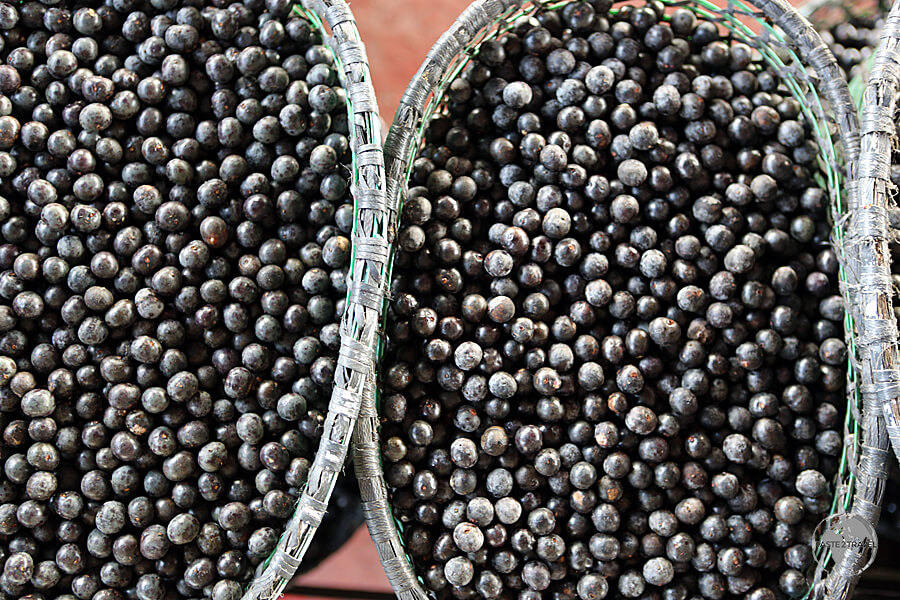
After timber exports, Açaí berries are the 2nd most valuable export item for the Amazon region.
Although Brazil is famous for its production of Açaí , the species is native to Brazil, Ecuador, Venezuela, Colombia, Guyana, French Guiana, Suriname and Trinidad and Tobago where it grows in swamps and floodplains.

Açaí palms in the grounds of the Casarão da Amazônia hotel on Marajó Island.
Açaí palms, such as the ones pictured here in the garden of the Casarão da Amazônia hotel on Marajó Island, are tall, slender trees growing to more than 25 m (82 ft) in height.
Marajó Island

The captain of our ferry from Marajó Island to Belém, with the usual afternoon storm raging outside.
Passenger ferries leave Belém daily from the Terminal Hidroviário (Pier 9), arriving approximately 3.5 hours later in the port of Camará. Please refer to the Marajo Island section for more details.

The daily afternoon storm rages over Belém as we return from Marajó Island.
Bus
Unlike most other cities along the Amazon River, Belém is connected to the main Brazilian road network. Frequent buses depart from the large Terminal Rodoviario de Belem (website only available in Portuguese) to a number of major cities in Brazil as well as other cities and smaller towns in Pará.
You can check timetables, costs and current seat availability online using the Busca Onibus website.
Getting Around
Road
Taxi’s in Belém are plentiful and relatively inexpensive for short distances.
There are many local buses travelling all over the city, although it can be difficult for non-Portuguese speakers to figure out the timetables and routes. Best to take a taxi or walk.
Marajó Island
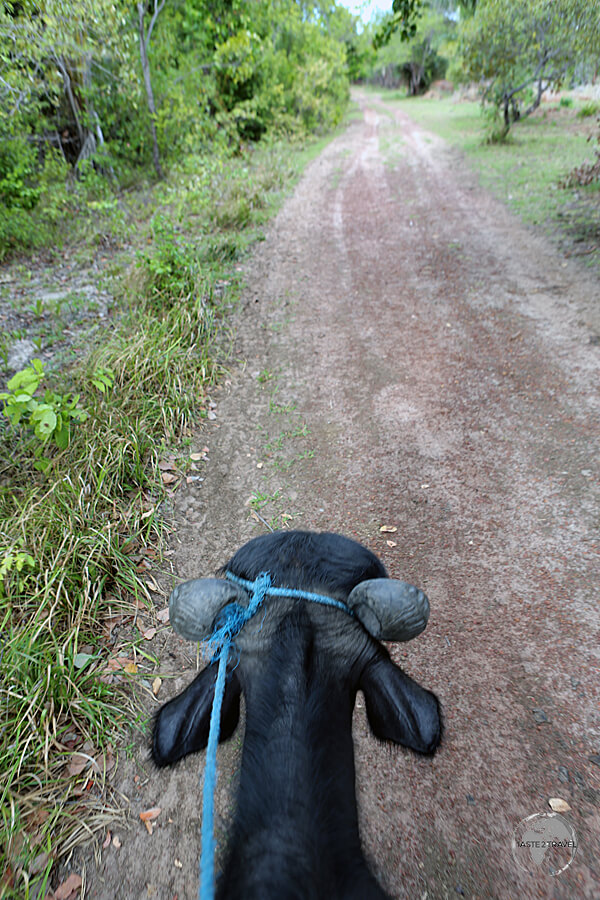
The view from atop my Buffalo at São Jerônimo Farm, Marajó Island.
Introduction
With a population of 200,000 living on an island the size of Switzerland in the mouth of the Amazon River, sparsely populated Marajó Island remains a world apart.
Almost all of the island is undeveloped, a huge virgin wetland which is the exclusive playground for tens of thousands of birds.
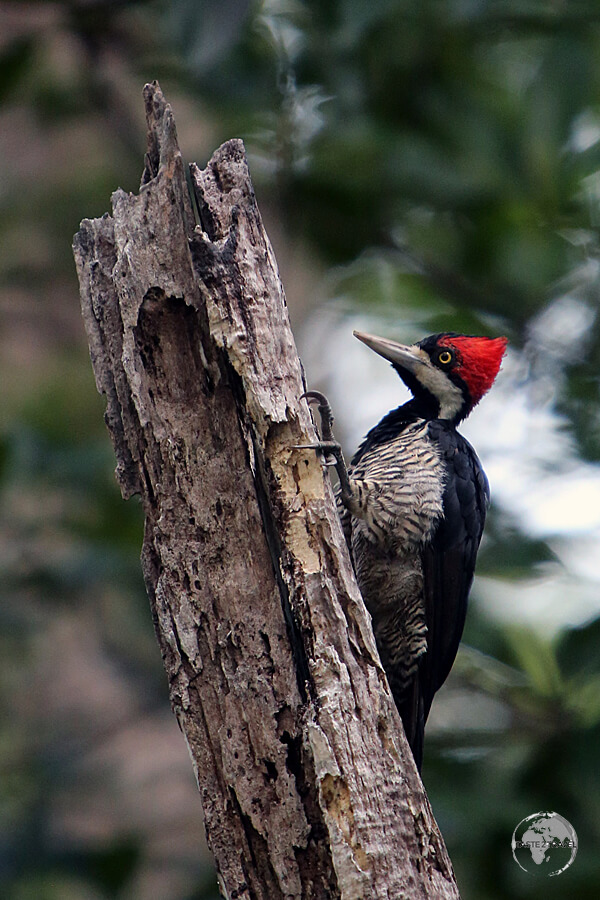
A Pileated Woodpecker on Marajó Island.
The tiny human population clings to a small strip of the eastern shore, living in the towns of Joanes, Salvaterra and Soure (the quiet, relaxed ‘capital’ of Marajó).
The streets of Soure are very quiet as there are few cars on the island but it’s here you’ll find the best accommodation and dining options.

A boardwalk provides access to the mangrove swamp at São Jerônimo Farm, Marajó Island.
Sightseeing
There are few man-made sights on the island but plenty of stunning natural sights. A wonderful introduction to the beauty of the island is offered by the owners of the Fazenda São Jerônimoe (São Jerônimo Farm), which is located 3 kilometres north of Soure on the road to Praia do Pesqueiro.

Marajó Island features miles of deserted, sandy beaches, including Praia do Pesqueiro.
During a two hour tour, you get to ride a buffalo (the buffalo population on the island out-numbers the human population), walk on an elevated boardwalk through a mangrove, stroll along a deserted sandy beach, then return to the farm via a boat ride through the mangrove, where you can spot many different birds, including Scarlet Ibis.
Accommodation

An old boat serves as a curb-side garden outside the Casarão da Amazônia hotel in Soure, the sleepy capital of Marajó Island.
Booking.com lists 12 properties on Marajó Island, most of which line the quiet (traffic-free) streets of Soure. While on the island, I stayed at (and would recommend) Casarão da Amazônia which is set in a renovated, brightly painted, colonial mansion (built in 1896) and is a 3-minute walk from the centre of Soure.
Update 15/11/2020: Due to the Covid pandemic, the Casarão da Amazônia is closed until 30/06/2021.
The hotel provides breakfast and features a swimming pool, spacious, charming rooms and a beautiful garden with various (labelled) local fruit trees and Açaí palms.

The Casarão da Amazônia hotel is housed in a renovated colonial-era mansion.
Eating
On an island where Buffalo are so numerous, it should come as no surprise that there are many opportunities to sample this lean (much healthier than fatty beef) and tasty meat. There are numerous restaurants in downtown Soure offering Buffalo meals and local fish dishes.
Getting There
Air
There is one small (non-commercial) airport in Soure. Air taxis can apparently be chartered from Belém.
Boat

Boats at Camará port, the main gateway to Marajó Island.
The only real way of getting to Marajo is via the daily passenger ferries which depart Belém from the Terminal Hidroviário Pier 9, arriving 3.5 hours later at Foz do Rio Camará – Terminal Hidroviário.
Mini buses transfer passengers from Camará port to Soure (35 kilometres/ 1.5 hours), via the smaller town of Savaterra, which lies on the opposite bank of the Paracauari River.
Timetable Belém/ Marajó:
- Monday to Saturday: 6.30 and 14.30
- Sunday: 10.00
Timetable Marajó/ Belém :
- Monday to Saturday: 6.30 and 15.00
- Sunday: 15.00
Tickets cost R$20,00 in economy class or R$35,00 in 1st class.

Returning to Belém on the ferry from Marajó Island.
Getting Around

The streets of Soure are eerily quiet due to an absence of cars on Marajó Island.
Road
Mini Buses connect the two towns of Soure and Salvaterra with Camará port.
Macapá

View of the Amazon River from Fortaleza de São José de Macapá.
Introduction
It’s actually easier to reach Macapá from neighbouring French Guiana than from the rest of Brazil, thanks to a highway that connects the city with Cayenne, the capital.

Canine-class on the boat from Belém to Macapá.
Macapá is strategically located on the northern channel of the Amazon River, near its mouth on the Atlantic ocean. At 400 kilometres (250 miles) across, the mouth is the widest in the world and effectively isolates Macapá from the rest of Brazil. The city has no land connections to other parts of Brazil, except other cities in Amapá state and French Guiana.

A boat cruising on the wide mouth of the Amazon River near Macapá.
I arrived in the capital of Amapá state after spending a leisurely 24-hours crossing the mouth of the river on a slow boat from Belém (see the ‘Getting There – Boat‘ section below for details on the journey). During the colonial period the state was called Portuguese Guiana and so it was fitting that Macapá should serve as the launch pad for my foray into the other Guiana’s.
Macapá (pop: 500,000) is a relaxed, laid-back capital and, while not brimming with attractions, is a pleasant enough place to spend time recuperating between journey’s. I spent two days in the city before boarding a night bus to Oiapoque on the French Guiana border.
Sightseeing
Fortalzeza de Sao Jose de Macapá

The Portuguese-built Fortalzeza de Sao Jose de Macapá stands at the mouth of the Amazon river at Macapá.
The main attraction in Macapá is the sprawling ruin of the fort – Fortalzeza de Sao Jose de Macapá. The fort was built at the mouth of the Amazon by the Portuguese from 1764 to 1782 as a defence against the French who took control of what is now French Guiana in 1677. Entrance to the fort is free and while all information is in Portuguese, the sweeping views of the Amazon river require no translation.
Marco Zero Monument

The Marco Zero monument in Macapa indicates the Equatorial line.
Located 6 kilometres from downtown on Avenue Equatorial, the Marco Zero monument was built to mark the position of the equator, which cuts through the city. Where else can you stand on the equator? Or stand in both hemispheres? Or hop/ skip over the equator?
The 30-metre tall tower has a large open circle at its top. Twice a year, at the spring and autumn equinoxes, the sun aligns with that circle, focusing a line of sunlight along the equator.
Accommodation
Macapá offers a good selection of accommodation catering to all budgets from hostels to 4-star hotels. While in town, I stayed at the 4-star Hotel Do Forte, which is one of the better hotels in town. Located downtown, this comfortable, clean and modern hotel is a short walk from restaurants, bars and attractions such as the fort and the river. You can book properties using booking.com
Eating Out
Sleepy Macapá offers a surprisingly good number of restaurants with the standout being the Amazonas Peixaria. Overlooking the Amazon river, this is a good place to eat local fish and sample Amazonian cuisine.
Getting There/ Away
Air
A slow boat from Belém to Macapá takes 24 hours, while a flight takes just 55 minutes (but is nowhere near as adventurous). Not surprisingly, many people choose to fly to Macapá, which is served by Alberto Alcolumbre International Airport (located 3 kilometres north-west of downtown).
The following airlines provide regular flights:
- LATAM Brasil – flies four times a week to/from Belém & Brasília
- Gol Airlines – flies twice a week to/from Belém & Brasília
- Azul Brazilian Airlines – flies daily to/from Belém
Boat
From Belém:
Please refer to the Belém section for details on boat travel to Macapá.
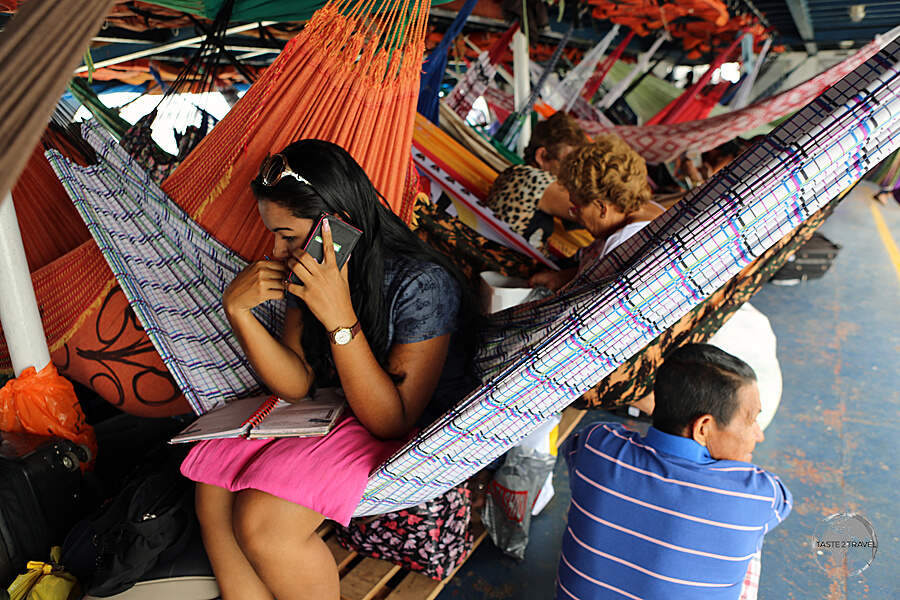
The very crowded ‘hammock-class’ on the M/V Sao Francisco de Paula which connects Macapá and Belém.
From Macapá:
The M/V Sao Francisco de Paula, returns to Belém from Macapá (Santana) twice a week, completing the journey in 24 hours.

Two fellow passengers, who loved posing for my camera, on the boat from Belém to Macapá.
Road
The road network in Amapá state is disconnected from the rest of Brazil, so long distance bus services are limited to within Amapá state.
The most useful connection for travellers are the two nightly Amazontur buses which make the 600-kilometre journey north along route BR156 to the border town of Oiapoque.
Buses depart from Macapá bus station at 17:00 and 18:00, arriving at the very quiet (and normally shut) Oiapoque bus station around dawn.

Early morning at Oiapoque bus station which was closed when I arrived at 5 am.
My bus seemed to cover the distance between Macapá and Oiapoque in record time, arriving at 5:00 am, where I was deposited at the very tiny, and closed, Oiapoque bus station.
It was great to have arrived early but the Brazilian immigration office wouldn’t open until 8:00 am, so I had no option but to sleep on a bench at the bus station until the border opened.
The immigration office is located a short walk from the river but requires a taxi ride from the bus station.

Built at a cost of US$50 million, the very grand Oiapoque bridge connects Brazil and French Guiana – the only land connection throughout the Guiana’s.
Crossing from Brazil to French Guiana
Oiapoque, AP, 68980-000, Brazil
The Brazilian border town of Oiapoque is located on the banks of the Oyapok river, slightly upstream from the town of St. Georges in neighbouring French Guiana (click to read my French Guiana Travel Guide).
The border crossing over the Oyapok river is the only one in the Guiana’s which can be made via a bridge, but only if you are travelling in a vehicle.
This is where Brazil meets the European Union!
At the time of my visit in 2015, the bridge hadn’t been opened so I took a boat across the river, a journey of just 10 minutes, in which time I travelled from Brazil across to the European Union! It was strange to disembark in the sleepy town of St. Georges to see the French and EU flags fluttering in the wind.
Breakfast tip:
If you arrive at the border in the morning, it’s best to take breakfast in St. Georges where you’ll find French-style cafés, pâtisseries and boulangeries serving crusty baguettes and fluffy omelettes. So much better than the standard Brazilian breakfast of chocolate cake.
The Oiapoque Bridge
The Oiapoque bridge is a grand construction project which was intended to be a key plank in a highway connecting Cayenne and Macapá. An idea conceived between two presidents without any thought given to the practicalities on the ground. Consequently, the whole project has been lambasted as a US$50 million white elephant!
The bridge was completed in 2011 but, due to politics between Brazil and France, was not opened until March of 2017.
When it was opened, the bridge was only open to vehicular traffic of which there is very little since the French government insists on Brazilian vehicles paying a substantial amount for vehicle insurance.
Most people cross the border on foot, in which case they still use the boats which provide a direct connection between downtown Oiapoque and downtown St. Georges.
The bridge forms the only land connection between Brazil and France – or Brazil and the European Union and is the only bridge-crossing on any of the borders in the Guianas.
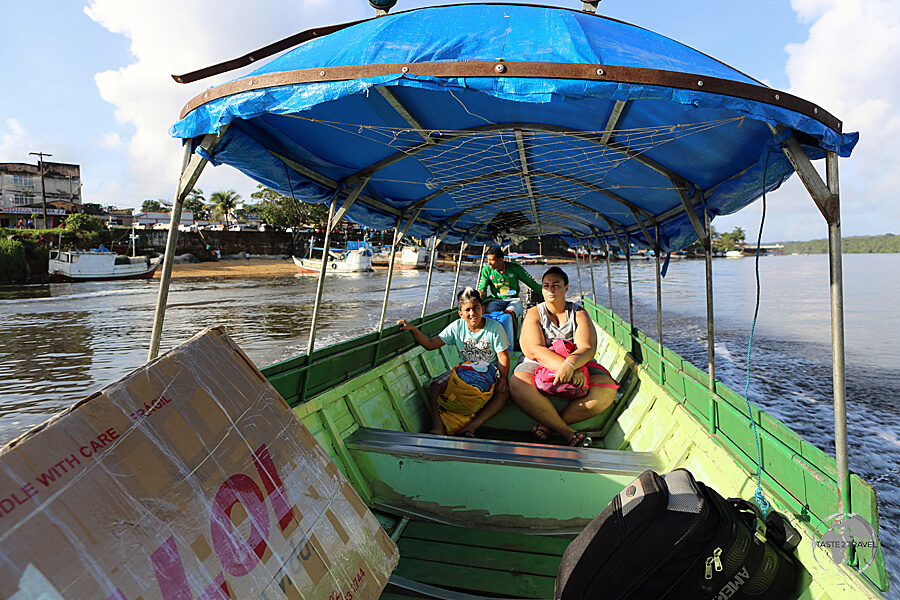
An early morning crossing on the Oyapok River from Brazil to French Guiana.
The end of the road for this epic journey…
You might also like…

Travel Guide: Macapá to Manaus via the Guiana’s & Venezuela
A travel guide detailing an overland meander from Macapá to Manaus via French Guiana, Suriname, Guyana and Venezuela
That’s the end of my Amazon River Travel Guide.
Safe Travels!
Darren
Follow me on Instagram:
Further Reading
Other travel reports from the region include:
- French Guiana
- French Guiana (Cayenne Carnival)
- Guyana
- Guyana (Essequibo Region)
- Macapa to Manaus via the Guianas
- Suriname
- Venezuela (Gran Sabana Region)
Amazon River Travel Guide Amazon River Travel Guide Amazon River Travel Guide Amazon River Travel Guide Amazon River Travel Guide Amazon River Travel Guide Amazon River Travel Guide Amazon River Travel Guide Amazon River Travel Guide Amazon River Travel Guide Amazon River Travel Guide Amazon River Travel Guide Amazon River Travel Guide Amazon River Travel Guide Amazon River Travel Guide Amazon River Travel Guide Amazon River Travel Guide Amazon River Travel Guide
Author: Darren McLean
Darren McLean is an Australian full-time digital nomad who has spent 36 years on a slow meander around the globe, visiting all seven continents and 239 UN+ countries and territories.
He founded taste2travel to pique one’s curiosity and inspire wanderlust.






